
Virola is a genus of flowering plants in the nutmeg family, Myristicaceae. It includes medium-sized trees native to rainforests of the tropical Americas, ranging from southern Mexico to Bolivia and southern Brazil. Species are known commonly as epená, patricá, or cumala. They have glossy, dark green leaves and clusters of tiny yellow flowers, and may emit a pungent odor.

Nuphar is a genus of aquatic plants in the family Nymphaeaceae, with a temperate to subarctic Northern Hemisphere distribution. Common names include water-lily, pond-lily, alligator-bonnet or bonnet lily, and spatterdock.

Sterculia is a genus of flowering plants in the mallow family, Malvaceae: subfamily Sterculioideae. Members of the genus are colloquially known as tropical chestnuts. Sterculia may be monoecious or dioecious, and its flowers unisexual or bisexual.

Bactris setulosa is a species of flowering plant in the family Arecaceae. It is a medium-sized spiny palm which is found in Colombia, Venezuela, Ecuador, Peru, Trinidad and Tobago and Suriname. It is one of the largest species of Bactris and is found at the highest elevations.
Mayna pubescens is a species of flowering plant in the family Achariaceae. It is endemic to Colombia.
Mayna suaveolens is a species of flowering plant in the family Achariaceae. It is endemic to Colombia.

Metteniusa is a genus of flowering plants in the family Metteniusaceae. It was named by Hermann Karsten in 1860 for the German botanist Georg Heinrich Mettenius. It has seven species. The type species is Metteniusa edulis.. "Metteniusaceae" was proposed by Adalbert Schnizlein and validated by Hermann Karsten in 1860.. The family is now placed in its own order, Metteniusales.
Metteniusa edulis is a species of flowering plants in the family Metteniusaceae. It was formerly placed in the family Cardiopteridaceae. It is endemic to Colombia.

Ruagea is a genus of plants in the family Meliaceae. It contains the following species :

Schmardaea is a genus of trees in the family Meliaceae. It solely comprises the species Schmardaea microphylla.
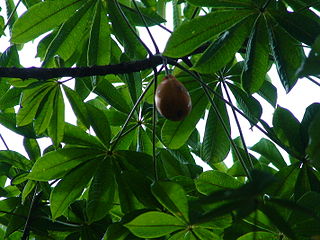
Jacaratia is a genus of shrubs or trees in the family Caricaceae. They are native to South and Central America.
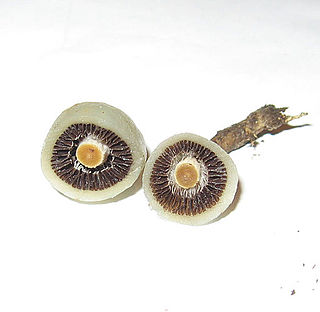
Weraroa was a genus of mushrooms from the families Hymenogastraceae and Strophariaceae. The genus was initially described by mycologist Rolf Singer in 1958 to accommodate the single species Secotium novae-zelandiae reported by Gordon Herriott Cunningham in 1924. It was thought that the genus represented an intermediary evolutionary stage between a hypogeous (underground) ancestor and the related epigeous genus Stropharia. Advances in phylogenetics and taxonomic changes since 1958 found it contained unrelated species from multiple genera. It is now considered a synonym of the genus Psilocybe.

Sabal mauritiiformis, commonly known as the Savannah palm, is a species of flowering plant in the family Arecaceae. It grows in Mexico, Central America, Colombia, Venezuela and Trinidad.
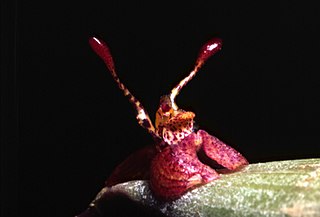
Myoxanthus reymondii is a species of flowering plant in the family Orchidaceae. It is native to Colombia, Ecuadorand Venezuela.
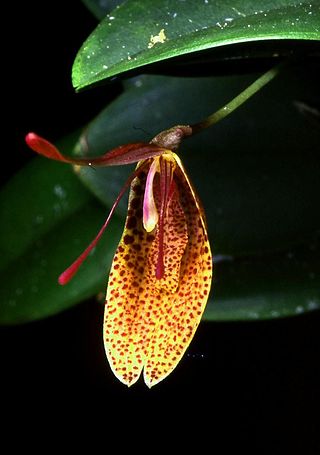
Restrepia elegans, commonly called the elegant restrepia, is a species of flowering plant in the family Orchidaceae. It is native to Colombia and northwestern Venezuela.

Alwyn Howard Gentry was an American botanist and plant collector, who made major contributions to the understanding of the vegetation of tropical forests.
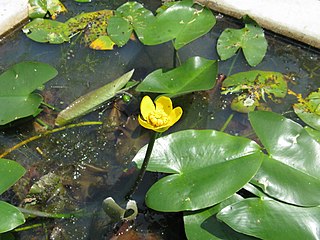
Nuphar japonica, known as East Asian yellow water-lily, is a perennial, aquatic, rhizomatous, herb in the family Nymphaeaceae native to Japan, Korea, and Russia.

Hedyosmum cumbalense is a species of tree in the family Chloranthaceae. It is native to South America.

Prockia is a genus of flowering plants in the family Salicaceae. It consists of approximately six species of shrubs and small trees native to the West Indies, Mexico, Central America, and South America. Its type species, Prockia crucis, is highly polymorphic and has a broad distribution, from Mexico and the West Indies to Uruguay and northern Argentina.

Lacmellea edulis, common name: chicle muyu, is a species of tree in the family Apocynaceae. It is native to Panama, Colombia, Venezuela, Brazil, Peru and Ecuador.
















